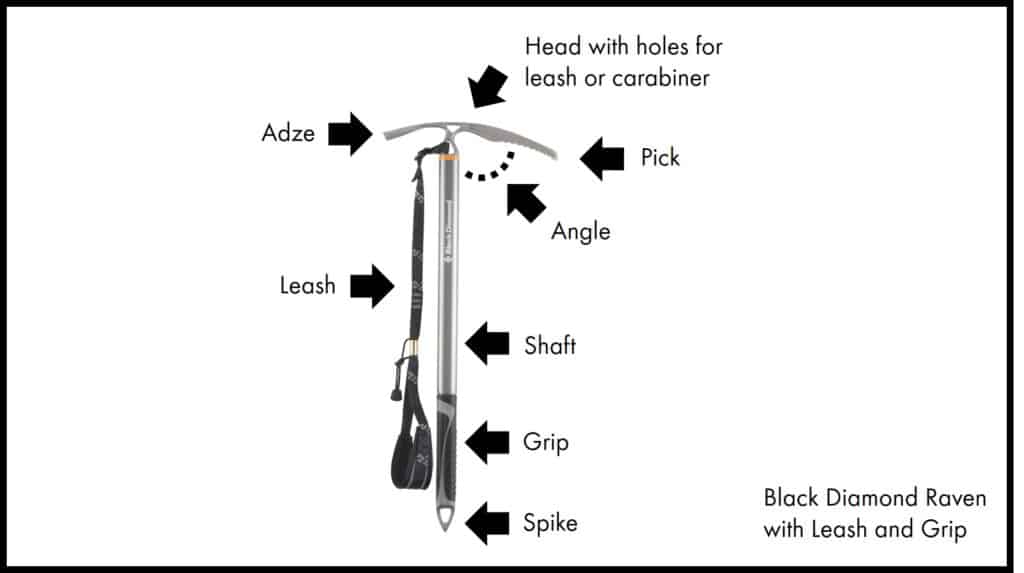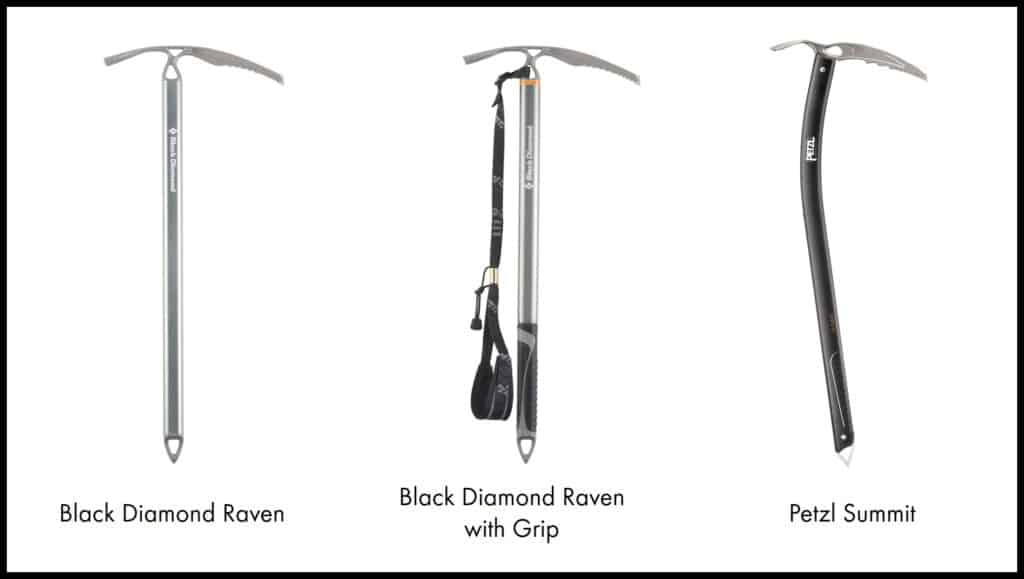An ice axe and crampons are likely to be your first set of technical climbing equipment.
An ice axe is a piece of important safety equipment. And you don’t want to burn a hole in your wallet for a decent ice axe.
These are my top 2 ice axe recommendations for winter hiking and mountaineering:
- Black Diamond Raven (click here to check the current price on Amazon): Hands down the best value for money in the market. At less than US$100, it is perfect for beginners who are starting out on glacier hikes or mountaineering over gentle to moderate terrains.
- Petzl Summit (click here to check the current price on Amazon): If you would like something that can grow with you as you progress to steeper and more challenging climbs, the Petzl Summit is worth the extra bucks.
What’s The Difference Between An Ice Axe And Ice Tool?
Some people may use the terms ice axe and ice tool interchangeably. But they are actually 2 different sets of equipment.
An ice axe is used for winter hiking or mountaineering. It is used for arresting falls or cutting steps into hard ice or snow. It also functions as a hiking stick to maintain balance. You usually only use 1 ice axe. An ice axe is usually longer and has a straighter profile
On the other hand, an ice tool is typically used by advanced climbers or mountaineers. They use it for technical climbing such as on glaciers or other vertical ice and snow surfaces. Ice tools are typically used in a set of 2. An ice tool is usually shorter and more curved.
Find out more about the differences between an ice axe and ice tool here.
Anatomy Of Ice Axe

Head, pick and adze
The head is the shorter section of the ice axe. The sharper end of the head is the pick. The pick is typically used for arresting falls. You use it to cut into the ice to break your fall. The other end is the adze. It’s kind of like a shovel and it is used to cut steps into the ice for walking.
There may be some holes in the middle of the head to attach leashes or carabiners.
When you are using the ice axe as a hiking stick, you will use the head as the handle.
It is typically made of stainless steel.
Shaft
This is the long section of the ice axe. An ice axe typically comes in many lengths, ranging from 21 to 35 inches (55 to 90 cm).
The shaft can be straight or slightly bent. The bent ones are more suited for steeper slopes.
Some shafts are cylindrical while others may be wider from front to back to provide a better grip.
It is typically made of wood or lightweight metal or composites.
.
Spike
The spike is the sharp pointy end of the shaft. It cuts into the ice or snow when you are using the ice axe as a hiking stick.
It is typically made of steel.
Leash
A short strap that you can loop around your wrist. This prevents you from dropping or losing your ice axe during a fall.
Leash stop
This stops the leash from sliding off the shaft.
Why I Chose The Black Diamond Raven
- Extremely affordable for a general mountaineering ice axe.
- Both the head and shaft of the Raven are very comfortable to hold.
- The shaft is made of aircraft grade aluminum, making it tough but light. It is also not too light.
- The adze works very well for chopping into hard ice or snow.
- The spike sinks into ice and snow very easily.
- I have not personally tested this but there are good reviews on its self-arrest capability.
- Climbers of all heights and needs will be able to find a Raven of a suitable length. The ice axe comes in 8 different lengths from 55 cm to 90 cm (5 cm intervals). Most other ice axes only have 3 to 5 different lengths.
The Black Diamond does well for glacier walks and basic snow climbs on gentle to moderate slopes. But it is not the best option for steep slopes. It has a straight shaft and a wide angle between the pick and the shaft. This makes it tougher to get good support when the slopes are steep.
Why The Petzl Summit Might Be Worth The Upgrade
- The Petzl has all the benefits of the Black Diamond Raven, and more.
- It is lighter than the Raven and just as comfortable to use.
- And while the Raven’s head is laser cut, the head of the Petzel Summit is hot forged. This creates a head that is stronger, more durable and thinner. It makes it suitable even on mixed climbs where you encounter ice and rocks.
- The thinner head profile and the curved shaft make the Petzel SUmmit superior to the Black Diamond Raven for steep slopes. It can do well even up to 70 degrees slopes and some even use them for vertical climbs.
But the Petzl Summit is pricier than the Black Diamond Raven. It is worth the money only if you find yourself trekking over a wide range of gentle to very steep terrains.
Comparison At A Glance: Black Diamond Raven Vs Petzl Summit

| Black Diamond Raven | Petzl Summit | |
| Length and weight | 22 in to 35 in (every 2 in) 16.1 oz for the 22 in 55 cm to 90 cm (every 5 cm) 456 g for the 55 cm | 20 in, 12.7 oz 23 in, 13.4 oz 26 in, 14.1 oz 52 cm, 360 g 59 cm, 380 g 66 cm, 400 g |
| Material | Stainless steel head Aluminum alloy shaft | Stainless steel head Aluminum alloy shaft |
| Self-arrest | Good | Excellent |
| Chopping steps | Good | Excellent |
| Steep ice and snow | Not as good | Good |
| Comfortable to use | Excellent | Good |
| CEN rating | CEN-B | CEN-B |
| Warranty | 1 year | 3 years |
| Check the latest price on Amazon | – Black Diamond Raven – Black Diamond Raven with Grip | Petzl Summit |
Ice Axe And Weight
For most climbing gear, light is always right. But not so for an ice axe. A heavier ice axe makes it easier to chop steps into ice and perform self-arrest.
Ice Axe And CEN Ratings
All ice axes have a Comité Européen de Normalisation (CEN) certification. The European certification assigns a Basic (B) or Technical (T) rating.
A CEN-T ice axe can be used to technical climbing but not a CEN-B ice axe.
Compared to a CEN-T rated ice axe, a CEN-B rated ice axe is generally:
- Lighter
- Less durable
- Less expensive
How To Choose The Right Length For Your Ice Axe?
This is the typical way to determine the length of an ice axe that is suitable for you.
- Stand upright with your arms straightened at your side.
- Hold the ice axe at the head.
- The spike of the ice axe should barely touch the ground.
This is a general guide based on your height:
| Height | Length of ice axe |
| < 5 ft 8 in < 172 cm | 20 to 24 in 50 to 60 cm |
| 5 ft 8 in — 5 ft 8 in 172 — 180 cm | 24 to 28 in 60 to 70 cm |
| > 5 ft 11 in > 180 cm | 24 to 30 in 60 to 75 cm |
But depending on the climb, you may find yourself needing a slightly longer or shorter ice axe.
If you are mainly traveling on gentle terrains, a longer ice axe is easier to use as a hiking stick. If you expect slushy snow, your ice axe is likely to sink every time it hits the ground. A longer one might be useful as well.
But a longer ice axe can be difficult to perform self-arrest when you fall.
If you are mainly traveling on steep terrains, a shorter ice axe will be easier to use.
A short ice axe might also make it hard for self-arrest.
How To Use The Ice Axe As A Hiking Stick
How To Use The Ice Axe To Stop A Fall (i.e. Self-arrest)
How To Use The Ice Axe To Cut Steps Into The Ice Or Snow
How To Maintain Your Ice Axe
An ice axe can last for many years even with frequent usage. You can lengthen the life of your ice axe by keeping them in tip-top conditions.
- Clean them and dry them after each use. Even stainless steel are not immune to rusting. Rust will reduce the strength and durability of your ice axe.
- Do not wash them in hot water or place them under the sun for long periods of time.
- Store them in a cool and dry location.
- Cover the spikes on the crampons with point covers so that they do not damage other stuff or injure people.
- Using your ice axe frequently on hard rocks will dull the sharp ends and reduce their life span. Avoid this where possible.
What Ice Axe Accessories Do You Need?
- Leashes: to prevent your ice axe or tool from dropping.
- Grips: to improve the grip on an ice axe
- Storage bags or protector covers: to cover the sharp ends of your ice axe or ice tool and prevent them from damaging your other gear
